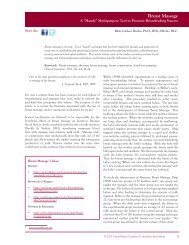Official Journal of the United States Lactation ... - Clinical Lactation
Official Journal of the United States Lactation ... - Clinical Lactation
Official Journal of the United States Lactation ... - Clinical Lactation
Create successful ePaper yourself
Turn your PDF publications into a flip-book with our unique Google optimized e-Paper software.
three weeks, two months, and four months (Bodley &<br />
Powers, 1996). In <strong>the</strong> 2004 study, 88% <strong>of</strong> <strong>the</strong> 200 women<br />
interviewed felt <strong>the</strong> nipple shield helped <strong>the</strong>m breastfeed,<br />
and 98% stated <strong>the</strong>y would use <strong>the</strong> nipple shield<br />
again with subsequent children if needed (Powers &<br />
Bodley Tapia, 2004). Nipple shields can be used in several<br />
different situations.<br />
Situations That May Warrant <strong>the</strong> Use <strong>of</strong><br />
Nipple Shield<br />
Infants with Inadequacies in Their Suck Due<br />
To Tongue-Tie, a Receding Jaw, Painful<br />
Cephalhematoma, or Prematurity<br />
Infants with <strong>the</strong>se issues <strong>of</strong>ten transfer an ounce or less,<br />
as measured by a pre- and post-feed weight on an electronic<br />
scale designed for test weighing. Usually, <strong>the</strong>ir<br />
weight is already trending downward, with more than a<br />
10% loss from <strong>the</strong>ir birth weight. A nipple shield may be<br />
used for <strong>the</strong> next feeding attempt, with pre- and postfeed<br />
weights to identify any improvement in milk transfer<br />
using <strong>the</strong> nipple shield. If <strong>the</strong> infant transfers more milk<br />
with <strong>the</strong> shield, <strong>the</strong> shield can be used until <strong>the</strong> infant is<br />
able to transfer adequate milk without it. This generally<br />
happens as <strong>the</strong> infant takes in more calories, <strong>of</strong>ten<br />
improving <strong>the</strong> sucking coordination and strength. There<br />
is no timetable for <strong>the</strong> infant’s readiness.<br />
Painful Nipples Where <strong>the</strong> Mo<strong>the</strong>r Says She<br />
Dreads Every Feeding<br />
By covering <strong>the</strong> damaged nipple, <strong>the</strong> shield may reduce<br />
fur<strong>the</strong>r injury, <strong>the</strong>reby speeding healing. Remind <strong>the</strong><br />
mo<strong>the</strong>r that even with <strong>the</strong> shield, <strong>the</strong> first minute or two<br />
<strong>of</strong> breastfeeding might still be painful, but after that <strong>the</strong><br />
pain should subside. When using <strong>the</strong> nipple shield for<br />
abraded nipples, <strong>the</strong> mo<strong>the</strong>r uses <strong>the</strong> shield until <strong>the</strong><br />
nipples have healed, with occasional use <strong>the</strong>reafter as<br />
needed. When nipples have been severely damaged, it is<br />
imperative to address <strong>the</strong> underlying cause <strong>of</strong> <strong>the</strong> soreness,<br />
most <strong>of</strong>ten incorrect latch and/or positioning <strong>of</strong><br />
<strong>the</strong> infant, so that when <strong>the</strong> shield is discontinued, abrasion<br />
to <strong>the</strong> tender nipple skin is not repeated.<br />
For Women Who Have Very Flat Nipples or<br />
Inverted Nipples<br />
If women are aware prior to delivery that this anatomical<br />
situation might prevent <strong>the</strong> infant from maintaining a<br />
latch, <strong>the</strong>y may have been wearing breast shells for <strong>the</strong><br />
last four weeks <strong>of</strong> pregnancy, providing <strong>the</strong>re was no history<br />
<strong>of</strong> pre-term labor. Based on <strong>the</strong> authors’ study <strong>of</strong><br />
200 breastfeeding women, breast shells helped to evert<br />
nipples approximately 50% <strong>of</strong> <strong>the</strong> time prior to <strong>the</strong><br />
infant’s birth (Powers & Bodley Tapia, 2004).<br />
Many pregnant women are not aware <strong>of</strong> <strong>the</strong> importance<br />
<strong>of</strong> nipple anatomy for ease <strong>of</strong> breastfeeding until <strong>the</strong>y<br />
have difficulty and seek assistance after delivery. This<br />
mo<strong>the</strong>r may need a nipple shield until <strong>the</strong> nipples are<br />
more easily graspable by <strong>the</strong> infant, or <strong>the</strong> infant develops<br />
greater sucking strength and coordination to<br />
maintain a latch on nipples with less-than-ideal<br />
elasticity.<br />
For Women with Hyperlactation<br />
If <strong>the</strong> mo<strong>the</strong>r produces a copious amount <strong>of</strong> milk, it can<br />
cause a newborn infant to choke, sputter, and pull away<br />
from <strong>the</strong> breast, sometimes turning red and struggling to<br />
brea<strong>the</strong>. This phenomenon is alarming to <strong>the</strong> mo<strong>the</strong>r<br />
and infant. Depending upon <strong>the</strong> child’s disposition,<br />
some infants will even go on a nursing strike when faced<br />
with too rapid a milk flow. A mo<strong>the</strong>r may find using a<br />
nipple shield will slow <strong>the</strong> flow <strong>of</strong> <strong>the</strong> milk into a more<br />
manageable quantity for <strong>the</strong> infant, since <strong>the</strong>re are only<br />
four holes in <strong>the</strong> nipple shield ra<strong>the</strong>r than a spray <strong>of</strong><br />
milk from approximately 7 to 15 nipple pores. The nipple<br />
shield is thus used to keep <strong>the</strong> baby breastfeeding<br />
with ease while <strong>the</strong> mo<strong>the</strong>r simultaneously downregulates<br />
her milk supply.<br />
Infants may handle high milk flow better if fed in an<br />
upright position, straddling <strong>the</strong> mo<strong>the</strong>r’s thigh, or prone<br />
on a mom lying flat on her back. Milk production can be<br />
reduced by breastfeeding on one breast only per feed. If<br />
<strong>the</strong>se techniques are insufficient to improve feeding<br />
within several days, <strong>the</strong> mo<strong>the</strong>r may increase <strong>the</strong> amount<br />
<strong>of</strong> hours spent breastfeeding on alternating sides. Some<br />
mo<strong>the</strong>rs find if <strong>the</strong>y feed <strong>the</strong> infant on just one breast<br />
per feeding, for as many as 12 hours, alternating with <strong>the</strong><br />
o<strong>the</strong>r breast, <strong>the</strong>y will successfully diminish <strong>the</strong> milk supply<br />
within several days. A mo<strong>the</strong>r might also take <strong>the</strong><br />
original Sudafed containing pseudoephedrine, as<br />
directed, for a couple <strong>of</strong> days to help downregulate her<br />
supply. (Note: This is an <strong>of</strong>f-label use <strong>of</strong> a medication<br />
that is non-prescription, but kept behind <strong>the</strong> counter <strong>of</strong><br />
pharmacies. It should not be used by women with hypertension,<br />
heart disease, or who are taking an MAOI<br />
antidepressant, or are allergic to any <strong>of</strong> <strong>the</strong> ingredients.)<br />
Once <strong>the</strong> milk supply decreases, <strong>the</strong> mo<strong>the</strong>r would no<br />
longer need a nipple shield to manage <strong>the</strong> milk flow.<br />
© 2012 <strong>United</strong> <strong>States</strong> <strong>Lactation</strong> Consultant Association 27




